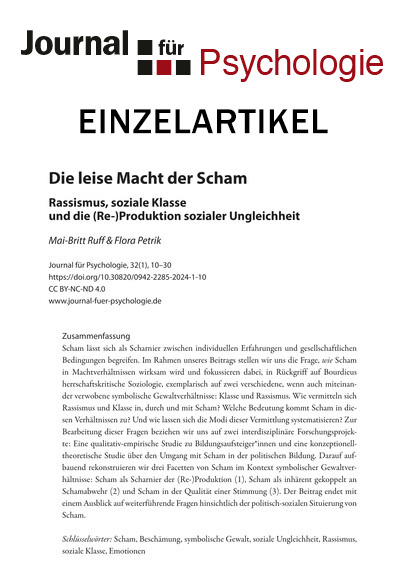The Quiet Power of Shame
Racism, Social Class, and the (Re-)Production of Social Inequality
DOI:
https://doi.org/10.30820/0942-2285-2024-1-10Keywords:
shame, shaming, symbolic violence, social inequality, racism, class, emotionsAbstract
Shame can be understood as a mediator between individual feelings and societal conditions. In our contribution, we pose the question of how shame becomes effective in power relations and, drawing on Bourdieu’s critical sociology of power, focus on two different, albeit intertwined, symbolic power relations: class and racism. How are racism and class mediated in, through and with shame? What is the role of shame in these relations? To address these questions, we refer to two interdisciplinary research projects: A qualitative-empirical study on social and educational upward mobility and a theoretical study on dealing with shame in civic education. Building on this, we reconstruct three facets of shame in the context of symbolic relations of violence: Shame as a hinge of (re)production (1), shame as inherently linked with shame defense mechanisms (2) and shame as a quality of attunement (3). The article ends with an outlook on further questions regarding the political-social situation of shame.
Downloads
How to Cite
Ruff, Mai-Britt, and Flora Petrik. 2024. “The Quiet Power of Shame: Racism, Social Class, and the (Re-)Production of Social Inequality”. Journal für Psychologie 32 (1):10-30. https://doi.org/10.30820/0942-2285-2024-1-10.
Issue
Section
Artikel
License

This work is licensed under a Creative Commons Attribution-NonCommercial-NoDerivatives 4.0 International License.
This license allows private use and unmodified distribution, but prohibits editing and commercial use (further information can be found at: https://creativecommons.org/licenses/by-nc-nd/4.0/).
The terms of the Creative Commons licence only apply to the original material. The reuse of material from other sources (marked with a reference) such as charts, illustrations, photos and text extracts may require further permission for use from the respective copyrights holder.


